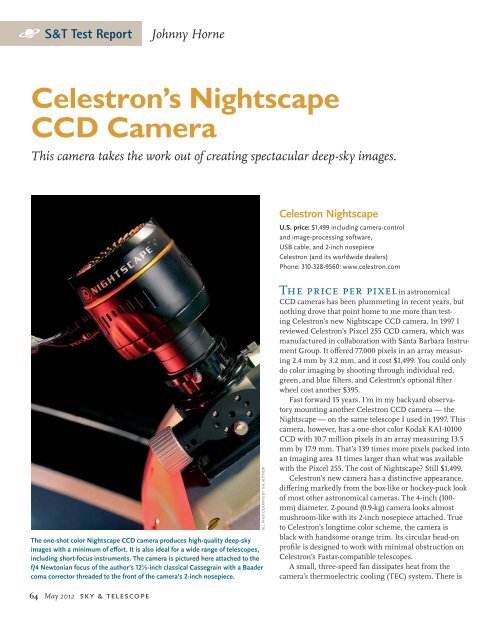Download this ebook as PDF - E-Book Library
Download this ebook as PDF - E-Book Library
Download this ebook as PDF - E-Book Library
Create successful ePaper yourself
Turn your PDF publications into a flip-book with our unique Google optimized e-Paper software.
S & T Test Report Johnny Horne<br />
Celestron’s Nightscape<br />
CCD Camera<br />
This camera takes the work out of creating spectacular deep-sky images.<br />
The one-shot color Nightscape CCD camera produces high-quality deep-sky<br />
images with a minimum of eff ort. It is also ideal for a wide range of telescopes,<br />
including short-focus instruments. The camera is pictured here attached to the<br />
f/4 Newtonian focus of the author’s 12½-inch cl<strong>as</strong>sical C<strong>as</strong>segrain with a Baader<br />
coma corrector threaded to the front of the camera’s 2-inch nosepiece.<br />
64 May 2012 sky & telescope<br />
ALL PHOTOGRAPHS BY THE AUTHOR<br />
Celestron Nightscape<br />
U.S. price: $1,499 including camera-control<br />
and image-processing software,<br />
USB cable, and 2-inch nosepiece<br />
Celestron (and its worldwide dealers)<br />
Phone: 310-328-9560: www.celestron.com<br />
The price per pixel<br />
in <strong>as</strong>tronomical<br />
CCD camer<strong>as</strong> h<strong>as</strong> been plummeting in recent years, but<br />
nothing drove that point home to me more than testing<br />
Celestron’s new Nightscape CCD camera. In 1997 I<br />
reviewed Celestron’s Pixcel 255 CCD camera, which w<strong>as</strong><br />
manufactured in collaboration with Santa Barbara Instrument<br />
Group. It off ered 77,000 pixels in an array me<strong>as</strong>uring<br />
2.4 mm by 3.2 mm, and it cost $1,499. You could only<br />
do color imaging by shooting through individual red,<br />
green, and blue fi lters, and Celestron’s optional fi lter<br />
wheel cost another $395.<br />
F<strong>as</strong>t forward 15 years. I’m in my backyard observatory<br />
mounting another Celestron CCD camera — the<br />
Nightscape — on the same telescope I used in 1997. This<br />
camera, however, h<strong>as</strong> a one-shot color Kodak KAI-10100<br />
CCD with 10.7 million pixels in an array me<strong>as</strong>uring 13.5<br />
mm by 17.9 mm. That’s 139 times more pixels packed into<br />
an imaging area 31 times larger than what w<strong>as</strong> available<br />
with the Pixcel 255. The cost of Nightscape? Still $1,499.<br />
Celestron’s new camera h<strong>as</strong> a distinctive appearance,<br />
diff ering markedly from the box-like or hockey-puck look<br />
of most other <strong>as</strong>tronomical camer<strong>as</strong>. The 4-inch (100mm)<br />
diameter, 2-pound (0.9-kg) camera looks almost<br />
mushroom-like with its 2-inch nosepiece attached. True<br />
to Celestron’s longtime color scheme, the camera is<br />
black with handsome orange trim. Its circular head-on<br />
profi le is designed to work with minimal obstruction on<br />
Celestron’s F<strong>as</strong>tar-compatible telescopes.<br />
A small, three-speed fan dissipates heat from the<br />
camera’s thermoelectric cooling (TEC) system. There is


